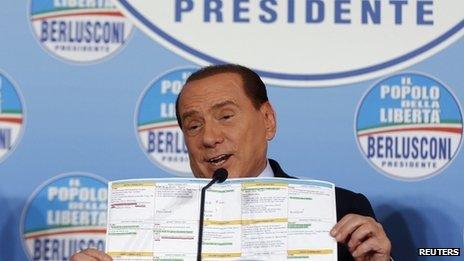Q&A: Italian election
- Published

Mr Berlusconi yet again proved his ability to stage a comeback
Two months after an inconclusive election, Italy finally appears to be getting a government.
President Giorgio Napolitano has asked Enrico Letta, of the centre-left Democratic Party, to become prime minister.
It follows a vote on 24-25 February that, according to many observers, left the country "ungovernable".
Three parties received almost equal shares of the vote, and had been unable to agree on a coalition.
The centre-left has control of the lower house, the Chamber of Deputies, but not the Senate.
A new coalition was agreed after Mr Letta met Mr Napolitano, with the president saying that the government would have the support of both houses.
Key appointments include Fabrizio Saccomanni as head of the powerful economy ministry and former European Commissioner Emma Bonino as foreign minister.
Blogger Beppe Grillo has called himself an "anti-Christ" of Italian politics
What was the outcome of the election?
What's at stake?
What about the president?
Pier Luigi Bersani achieved the slimmest of victories over the centre-right
What are the various political alliances involved?
Voters rebelled against Mario Monti's austerity agenda
What kind of electoral system does Italy have?
reports and analyses news from TV, radio, web and print media around the world. For more reports from ┤¾¤¾┤½├¢ Monitoring, click here. You can follow ┤¾¤¾┤½├¢ Monitoring on and .